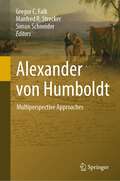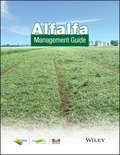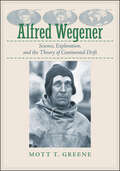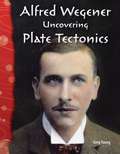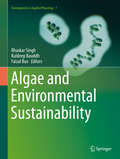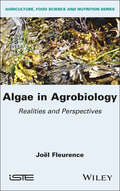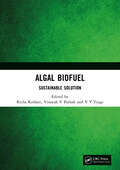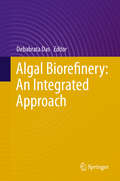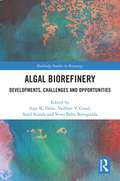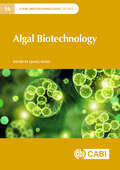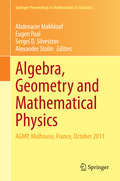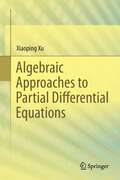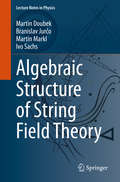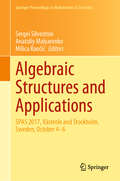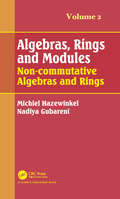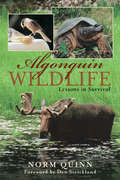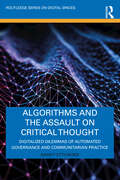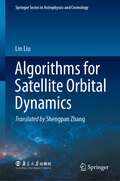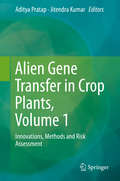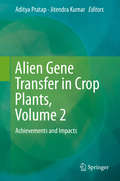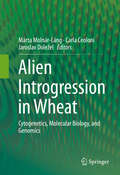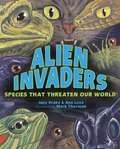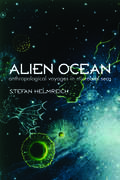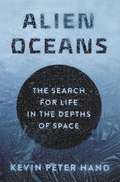- Table View
- List View
Alexander von Humboldt: Multiperspective Approaches
by Gregor C. Falk Manfred R. Strecker Simon SchneiderThis book aims to view and to understand Alexander von Humboldt from different perspectives and in varying disciplinary contexts. His contributions addressed numerous topics in the earth but also life sciences—spanning from geo-botany, climatology, paleontology, oceanography, mineralogy, resources, and hydrogeology to links between the environmental impact of humans, erosion, and climate change. From the very beginning, he paved the way for a modern, integrated earth system science approach to decipher, characterize, and model the different forcing factors and their feedback mechanisms. It becomes obvious that Humboldt’s holistic approach is far beyond simple description and empiric data collection. As documented and analyzed in the different texts of this volume, he combines observation and analysis with emotions and subjective perceptions in a very affectionate way. However, this publication does not intend to add another encyclopedic text compilation but to observe and critically analyze this unique personality´s relevance in a modern context, particularly in discussing environmental and social key issues in the twenty-first century.
Alfalfa Management Guide (ASA, CSSA, and SSSA Books #152)
by Dan Undersander Mark Renz Craig Sheaffer Glen Shewmaker Mark SulcLearn how to achieve top yields to maximize profits. This 2011 edition offers the latest information and strategies for alfalfa establishment, production, and harvest. Includes many color photos and charts.
Alfred Wegener: Science, Exploration, and the Theory of Continental Drift
by Mott T. GreeneA masterful biography of Alfred Wegener (1880–1930), the German scientist who discovered continental drift.Winner of the CHOICE Outstanding Academic Title of the Choice ACRLAlfred Wegener aimed to create a revolution in science which would rank with those of Nicolaus Copernicus and Charles Darwin. After completing his doctoral studies in astronomy at the University of Berlin, Wegener found himself drawn not to observatory science but to rugged fieldwork, which allowed him to cross into a variety of disciplines. The author of the theory of continental drift—the direct ancestor of the modern theory of plate tectonics and one of the key scientific concepts of the past century—Wegener also made major contributions to geology, geophysics, astronomy, geodesy, atmospheric physics, meteorology, and glaciology. Remarkably, he completed this pathbreaking work while grappling variously with financial difficulty, war, economic depression, scientific isolation, illness, and injury. He ultimately died of overexertion on a journey to probe the Greenland icecap and calculate its rate of drift. This landmark biography—the only complete account of the scientist’s fascinating life and work—is the culmination of more than twenty years of intensive research. In Alfred Wegener, Mott T. Greene places Wegener’s upbringing and theoretical advances in earth science in the context of his brilliantly eclectic career, bringing Wegener to life by analyzing his published scientific work, delving into all of his surviving letters and journals, and tracing both his passionate commitment to science and his thrilling experiences as a polar explorer, a military officer during World War I, and a world-record–setting balloonist. In the course of writing this book, Greene traveled to every place that Alfred Wegener lived and worked—to Berlin, rural Brandenburg, Marburg, Hamburg, and Heidelberg in Germany; to Innsbruck and Graz in Austria; and onto the Greenland icecap. He also pored over archives in Copenhagen, Munich, Marburg, Graz, and Bremerhaven, where the majority of Wegener’s surviving papers are found. Written with great immediacy and descriptive power, Alfred Wegener is a powerful portrait of the scientist who pioneered the modern concept of unified Earth science. The book should be of interest not only to earth scientists, students of polar travel and exploration, and historians but to all readers who are fascinated by the great minds of science.
Alfred Wegener: Uncovering Plate Tectonics: Earth and Space Science (Science Readers)
by Greg YoungIn this appealing biography, children will read about the fascinating life, theories, and discoveries of Alfred Wegener. From his time in Greenland studying meteorology with hot balloons to his theory of Pangea, readers will be eager to learn more about Wegener's contributions to science and the strides he took towards developing the study of plate tectonics. The easy-to-read text, accessible glossary, helpful index, and intriguing facts work in conjunction with the lively images and captivating lab activity to engage readers from beginning to end! <P><P>Lexile Measure: 630L
Algae and Environmental Sustainability (Developments in Applied Phycology #7)
by Faizal Bux Bhaskar Singh Kuldeep BauddhThis book presents the dynamic role of algae in a sustainable environment. Two major aspects, namely bioenergy and bioremediation, have been elaborated in various chapter contributed by scientists and teachers from different geographical areas throughout the world. Algal biofuels is an emerging area of equal interest to researchers, industries, and policy makers working or focusing on alternative (i. e. renewable) fuels. Algae have been an area of interest due to their wide range of applications. Over the last 5 decades, eukaryotic algae have been used in the aquaculture industry as feed for invertebrates, providing a rich source of antioxidants, dietary fiber, minerals and protein. More recently, there has been a focus on the use of algal biomass in the development of alternative fuels. The extraction of oil from algae has been widely explored as a much more viable feedstock than plant-based oils in large-scale fuel production. using algae as feedstock has the advantages that it doesn't require arable land and that wastewater can be used as a source of nutrients in their culture. The multifunctional approach of algae includes pollution remediation, carbon sequestration, biofuels production, and delivery of value-added products. However, there are still some obstacles that need to be overcome to make their use as potential feedstock for biofuels techno-economically feasible. In order to maintain the sustainability aspect of algal biofuels, various aspects have to be studied and critically analyzed to assess the long-term sustainability of algal derived biofuels. This book discusses the role of algae as a promising future feedstock for biofuels. They are known to sequester carbon in much larger amounts than plants and as such the book also describes their phycoremediation potential for conventional as well as emerging contaminants. It describes the role of anaerobic digestion in algal biorefineries; bioreactions and process parameters; biogas recovery and reuse. The role of algal biofilm based technology in wastewater treatment and transforming waste into bio-products is discussed, and remediation of sewage water through algae is assessed. The book also describes the production of biohydrogen, bio-oil, biodiesel; and the major bottlenecks in their usage. The emerging characterization techniques of these biofuels (bio-oil and biodiesel) are described, as are the decolorizing potential of algae and the genetic engineering techniques that could enhance the production of lipids in algae. Other aspects of the book include the role of remote sensing technology in the monitoring of algae and a life cycle assessment of algal biofuels.
Algae in Agrobiology: Realities and Perspectives
by Joel FleurenceAlgae, macroalgae and microalgae can be valuable biological resources in a new, more environmentally friendly form of agriculture known as agrobiology. Indeed, the biological properties associated with algae are frequently relevant for agricultural and zootechnical purposes. It is this aspect that is behind the current popularity of algae in the development of new agricultural practices that are related to plant and animal production, which are referred to as agrobiology. Algae in Agrobiology offers a current and forward-looking account of algae use: in agriculture and in the sector of land and marine animal production, as algal extracts and molecules in the form of fertilizers or biostimulants for crops with agronomic interest, and as algal compounds in the area of plant and animal health. This book is based on advances in biochemical and agronomic research in order to explain the conventional practices associated with the use of algae in agriculture and livestock breeding. These advances make it possible to establish possible uses for marine algal resources in the agriculture of the future.
Algal Biofuel: Sustainable Solution
by Richa Kothari V. V. Tyagi Vinayak V. PathakAlgal Biofuel: Sustainable Solution primarily focuses on the different aspects of bioenergy production using algal biomass as microalgae are considered the optimum feedstock for bioenergy production. The major aim is to thoroughly review the available bioenergy options, challenges in bioenergy production, availability of bioenergy feedstock, and biomass to bioenergy conversion process. This book also highlights the feasibility of lignocellulosic biomass, crop residues, and non-edible oil seeds for generation of different bioenergy products. It will be helpful for researchers and other stakeholders working in the area of bioenergy production for development of innovative concepts in emerging areas of bioenergy. Print edition not for sale in South Asia (India, Sri Lanka, Nepal, Bangladesh, Pakistan and Bhutan).
Algal Biorefinery: An Integrated Approach
by Debabrata DasThis book critically discusses different aspects of algal production systems and several of the drawbacks related to microalgal biomass production, namely, low biomass yield, and energy-consuming harvesting, dewatering, drying and extraction processes. These provide a background to the state-of-the-art technologies for algal cultivation, CO2 sequestration, and large-scale application of these systems. In order to tap the commercial potential of algae, a biorefinery concept has been proposed that could help to extract maximum benefits from algal biomass. This refinery concept promotes the harvesting of multiple products from the feedstock so as to make the process economically attractive. For the last few decades, algal biomass has been explored for use in various products such as fuel, agricultural crops, pigments and pharmaceuticals, as well as in bioremediation. To meet the huge demand, there has been a focus on large-scale production of algal biomass in closed or open photobioreactors. Different nutritional conditions for algal growth have been explored, such as photoautotrophic, heterotrophic, mixotrophic and oleaginous. This book is aimed at a wide audience, including undergraduates, postgraduates, academics, energy researchers, scientists in industry, energy specialists, policy makers and others who wish to understand algal biorefineries and also keep abreast of the latest developments.
Algal Biorefinery: Developments, Challenges and Opportunities (Routledge Studies in Bioenergy)
by Sonil Nanda Ajay K. Dalai Vaibhav V. Goud Venu Babu BorugaddaThis book enables readers to understand the theoretical aspects, key steps and scientific techniques with a detailed mechanism to produce biofuels from algae. Each chapter provides the latest developments and recent advancements starting from algal cultivation techniques to the production of value-added green fuels, chemicals and products with wide applications. The volume brings together a broad range of international and interdisciplinary experts, including chemical and biological engineers, biotechnologists, process engineers, environmentalists, pharmacists and nutritionists, to one platform to explore the beneficial aspects and challenges for an algal-based biorefinery. Chapters address cutting-edge issues surrounding algal cultivation, including genetic modification of algal strains, design and optimization of photobioreactors and open-pond systems, algal oil extraction techniques and algal-derived fuel products (biodiesel, bio-gasoline, jet fuels and bio-oil). Finally, the book considers the potential environmental impacts for establishing a sustainable algal biorefinery through lifecycle analysis, techno-economic assessment and supply chain management. This book will be an important resource for students, academics and professionals interested in algal cultivation, biofuels and agricultural engineering, and renewable energy and sustainable development more broadly.
Algal Biotechnology (CABI Biotechnology Series)
by Sanjay Gupta Jin Wang Vinod Kumar Xu Zhang Lei Chen Chao Li Weiwen Zhang Xinyu Song Xiaojun Yan Chengxu Zhou Roger Ruan Yahui Bo Gao Chen Zhenfan Chen Zixi Chen Pengfei Cheng Feng Ge Jiameng Guo Xiahui Hao Qingfang He Fan Hu Hanhua Hu Krishna Kumar Jaiswal Hu Jin Anping Lei Anna I. Kurbatova Yanhua Li Hanzhi Lin Lu-Ning Liu Qiong Liu Yandu Lu Anastasios Melis Yufang Pan Vishal Rajput Shengzhou Shan Kaitlin Simmons Xiaotong Song Adamu Yunusa Ugya Mikhail S. Vlaskin Chun Wang Jiangxin Wang Wenxiu Yin Xiangxiang Zhang Yu-Zhong Zhang Long-Sheng Zhao Quanyu Zhao Yali Zhu Zhu Zhen Tian Jing Cao XupengAlgae are sunlight-driven cell factories, and can efficiently absorb CO2 and convert light energy to chemical energy such as lipid, starch and other carbohydrates and release O2. Algal feedstock is a promising resource for bioproduct production, given its high photosynthetic efficiency for producing biomass compared to conventional crops. Microalgae can be used for flue-gas and wastewater bioremediation. This book highlights recent breakthroughs in the multidisciplinary areas of algal biotechnology and the chapters feature recent developments from cyanobacteria to eukaryotic algae, from theoretical biology to applied biology. It also includes the latest advancements in algal-based synthetic biology, including metabolic engineering, artificial biological system construction and green chemicals production. With contributions by leading authorities in algal biotechnology research, it is a valuable resource for graduate students and researchers in the field, and those involved in the study of photosynthesis and green-cell factories.
Algebra, Geometry and Mathematical Physics: AGMP, Mulhouse, France, October 2011 (Springer Proceedings in Mathematics & Statistics #85)
by Abdenacer Makhlouf Eugen Paal Sergei D. Silvestrov Alexander StolinThis book collects the proceedings of the Algebra, Geometry and Mathematical Physics Conference, held at the University of Haute Alsace, France, October 2011. Organized in the four areas of algebra, geometry, dynamical symmetries and conservation laws and mathematical physics and applications, the book covers deformation theory and quantization; Hom-algebras and n-ary algebraic structures; Hopf algebra, integrable systems and related math structures; jet theory and Weil bundles; Lie theory and applications; non-commutative and Lie algebra and more. The papers explore the interplay between research in contemporary mathematics and physics concerned with generalizations of the main structures of Lie theory aimed at quantization and discrete and non-commutative extensions of differential calculus and geometry, non-associative structures, actions of groups and semi-groups, non-commutative dynamics, non-commutative geometry and applications in physics and beyond. The book benefits a broad audience of researchers and advanced students.
Algebraic Approaches to Partial Differential Equations (Springer Monographs in Mathematics)
by Xiaoping XuThis book presents the various algebraic techniques for solving partial differential equations to yield exact solutions, techniques developed by the author in recent years and with emphasis on physical equations such as: the Maxwell equations, the Dirac equations, the KdV equation, the KP equation, the nonlinear Schrodinger equation, the Davey and Stewartson equations, the Boussinesq equations in geophysics, the Navier-Stokes equations and the boundary layer problems. In order to solve them, I have employed the grading technique, matrix differential operators, stable-range of nonlinear terms, moving frames, asymmetric assumptions, symmetry transformations, linearization techniques and special functions. The book is self-contained and requires only a minimal understanding of calculus and linear algebra, making it accessible to a broad audience in the fields of mathematics, the sciences and engineering. Readers may find the exact solutions and mathematical skills needed in their own research.
Algebraic Structure of String Field Theory (Lecture Notes in Physics #973)
by Martin Doubek Branislav Jurčo Martin Markl Ivo SachsThis book gives a modern presentation of modular operands and their role in string field theory. The authors aim to outline the arguments from the perspective of homotopy algebras and their operadic origin. Part I reviews string field theory from the point of view of homotopy algebras, including A-infinity algebras, loop homotopy (quantum L-infinity) and IBL-infinity algebras governing its structure. Within this framework, the covariant construction of a string field theory naturally emerges as composition of two morphisms of particular odd modular operads. This part is intended primarily for researchers and graduate students who are interested in applications of higher algebraic structures to strings and quantum field theory. Part II contains a comprehensive treatment of the mathematical background on operads and homotopy algebras in a broader context, which should appeal also to mathematicians who are not familiar with string theory.
Algebraic Structures and Applications: SPAS 2017, Västerås and Stockholm, Sweden, October 4-6 (Springer Proceedings in Mathematics & Statistics #317)
by Anatoliy Malyarenko Sergei Silvestrov Milica RančićThis book explores the latest advances in algebraic structures and applications, and focuses on mathematical concepts, methods, structures, problems, algorithms and computational methods important in the natural sciences, engineering and modern technologies. In particular, it features mathematical methods and models of non-commutative and non-associative algebras, hom-algebra structures, generalizations of differential calculus, quantum deformations of algebras, Lie algebras and their generalizations, semi-groups and groups, constructive algebra, matrix analysis and its interplay with topology, knot theory, dynamical systems, functional analysis, stochastic processes, perturbation analysis of Markov chains, and applications in network analysis, financial mathematics and engineering mathematics. The book addresses both theory and applications, which are illustrated with a wealth of ideas, proofs and examples to help readers understand the material and develop new mathematical methods and concepts of their own. The high-quality chapters share a wealth of new methods and results, review cutting-edge research and discuss open problems and directions for future research. Taken together, they offer a source of inspiration for a broad range of researchers and research students whose work involves algebraic structures and their applications, probability theory and mathematical statistics, applied mathematics, engineering mathematics and related areas.
Algebras, Rings and Modules, Volume 2: Non-commutative Algebras and Rings
by Michiel Hazewinkel Nadiya M. GubareniThe theory of algebras, rings, and modules is one of the fundamental domains of modern mathematics. General algebra, more specifically non-commutative algebra, is poised for major advances in the twenty-first century (together with and in interaction with combinatorics), just as topology, analysis, and probability experienced in the twentieth century. This is the second volume of Algebras, Rings and Modules: Non-commutative Algebras and Rings by M. Hazewinkel and N. Gubarenis, a continuation stressing the more important recent results on advanced topics of the structural theory of associative algebras, rings and modules.
Algonquin Wildlife: Lessons in Survival
by Norm Quinn Cassandra Ward Dan StricklandAlgonquin Wildlife: Lessons in Survival is a celebration of the vast array of wildlife studies ongoing in Ontario’s very first provincial park. Probably more research has been done in Algonquin than in any other protected landscape in the world. Norm Quinn, long-time Park Management Biologist in Algonquin, has been fortunate to know and to work with many of those dedicated and unique wildlife researchers who roam and probe the forests and lakes in search of Nature’s secrets. His knowledge, experience and sense of humour combine to transform technical biological studies, on moose, wolves, fish and other creatures of the wild, into entertaining and inviting stories without losing the significance of the research. This is also a book about Algonquin, Ontario’s flagship Park and one of the foremost canoe-tripping wilderness sites in the world. Through Algonquin Wildlife, you are invited to explore this relatively unknown but vital part of the Park’s heritage – a must for both seasoned and budding naturalists.
Algorithms and the Assault on Critical Thought: Digitalized Dilemmas of Automated Governance and Communitarian Practice (Routledge Series on Digital Spaces)
by Nancy EttlingerThis book examines the digitalization of longstanding problems of technological advance that produce inequalities and automated governance, which relieves subjects of agency and critical thought, and prompts a need to weaponize thoughtfulness against technocratic designs. The book situates digital-era problems relative to those of previous sociotechnical milieux and argues that technical advance perennially embeds corrosive effects on social relations and relations of production, recognizing variation across contexts and relative to entrenched societal hierarchies of race and other axes of difference and their intersections. Societal tolerance, despite abundant evidence for harmful effects of digital technologies, requires attention. The book explains blindness to social injustice by technocratic thinking delivered through education as well as truths embraced in the data sciences coupled with governance in universities and the private sector that protect these truths from critique. Institutional inertia suggests benefits of communitarianism, which strives for change emanating from civil society. Scaling postcapitalist communitarian values through communitybased peer production presents opportunities. However, enduring problems require critical reflection, continual revision of strategies, and active participation among diverse community citizens. This book is written with critical geographic sensibilities for an interdisciplinary audience of scholars and graduate and undergraduate students in the social sciences, humanities, and data sciences.
Algorithms for Satellite Orbital Dynamics (Springer Series in Astrophysics and Cosmology)
by Lin LiuThis book highlights the fundamental physics of orbit theory, dynamical models, methods of orbit determination, design, measurement, adjustment, and complete calculations for the position, tracking, and prediction of satellites and deep spacecraft. It emphasizes specific methods, related mathematical calculations, and worked examples and exercises. Therefore, technicians and engineers in the aerospace industry can directly apply them to their practical work. Dedicated to undergraduate students and graduate students, researchers, and professionals in astronomy, physics, space science, and related aerospace industries, the book is an integrated work based on the accumulated knowledge in satellite orbit dynamics and the author’s more than five decades of personal research and teaching experience in astronomy and aerospace dynamics.
Alien Gene Transfer in Crop Plants, Volume 1: Innovations, Methods and Risk Assessment
by Aditya Pratap Jitendra KumarGenetic engineering and biotechnology along with conventional breeding have played an important role in developing superior cultivars by transferring economically important traits from distant, wild and even unrelated species to the cultivated varieties which otherwise could not have been possible with conventional breeding. There is a vast amount of literature pertaining to the genetic improvement of crops over last few decades. However, the wonderful results achieved by crop scientists in food legumes’ research and development over the years are scattered in different journals of the World. <P><P> The two volumes in the series ‘Alien Gene Transfer in Crop Plants’ address this issue and offer a comprehensive reference on the developments made in major food crops of the world. These volumes aim at bringing the contributions from globally renowned scientists at one platform in a reader-friendly manner.<P><P> The 1st volume entitled, ‘Alien Gene Transfer in Crop Plants: Innovations, Methods and Risk Assessment” will deal exclusively with the process and methodology. The contents of this volume have been designed to appraise the readers with all the theoretical and practical aspects of wide hybridization and gene transfer like processes and methods of gene transfer, role of biotechnology with special reference to embryo rescue, genetic transformation, protoplast fusion and molecular marker technology, problems such as cross incompatibility and barriers to distant hybridization and solutions to overcome them. Since wild and weedy relatives of crop plants may have negative traits associated with them, there are always possibilities of linkage drag while transferring alien alleles. Therefore, problems and limitations of alien gene transfer from these species will also be discussed in this series. Further, the associated risks with this and assessment of risks will also be given due weightage.
Alien Gene Transfer in Crop Plants, Volume 2: Achievements and Impacts
by Aditya Pratap Jitendra KumarGenetic engineering and biotechnology along with conventional breeding have played an important role in developing superior cultivars by transferring economically important traits from distant, wild and even unrelated species to the cultivated varieties which otherwise could not have been possible with conventional breeding. There is a vast amount of literature pertaining to the genetic improvement of crops over last few decades. However, the wonderful results achieved by crop scientists in food legumes’ research and development over the years are scattered in different journals of the World. <P><P> The two volumes in the series ‘Alien Gene Transfer in Crop Plants’ address this issue and offer a comprehensive reference on the developments made in major food crops of the world. These volumes aim at bringing the contributions from globally renowned scientists at one platform in a reader-friendly manner. The second volume entitled, “Alien Gene Transfer in Crop Plants: Achievements and Impact” will deal more with the practical aspects. This volume will cover achievements of alien gene transfer in major food crops of the world and their impact on development of newer genetic variability and additional avenues for selection; development of superior cultivars for increased yield, resistance to biotic and abiotic stresses, improved nutritional and industrial quality; innovation of new techniques and positive as well as negative environmental implications. This volume has been divided into four groups with an aim to cover all major cereals, pulses, oilseeds and other crops (vegetable and horticultural crops) which are of economic importance.
Alien Introgression in Wheat: Cytogenetics, Molecular Biology, and Genomics
by Márta Molnár-Láng Carla Ceoloni Jaroslav DoleželThis book provides an overview of the latest advancements in the field of alien introgression in wheat. The discovery and wide application of molecular genetic techniques including molecular markers, in situ hybridization, and genomics has led to a surge in interspecific and intergeneric hybridization in recent decades. The work begins with the taxonomy of cereals, especially of those species which are potential gene sources for wheat improvement. The text then goes on to cover the origin of wheat, breeding in connection with alien introgressions, and the problems of producing intergeneric hybrids and backcross derivatives. These problems can include crossability, sterility, and unequal chromosome transmission. The work then covers alien introgressions according to the related species used, as well as new results in the field of genomics of wild wheat relatives and introgressions.
Alien Invaders: Species That Threaten Our World
by Jane Drake Ann LoveFrom killer toads, feral felines, and brown tree snakes to multiple invaders in Lake Victoria and the Great Lakes, Alien Invaders focuses on wave after wave of invaders that affect our ecosystems and the side-effects of climate change and modern global travel on our world today. Environmentalists and coauthors Jane Drake and Ann Love present the concepts of endangered species and biodiversity in this informative look at alien invaders and how they impact our world. From the days of sailing ships and shipboard rats to the fungus that sparked the Irish potato famine to the beautiful but deadly purple loosestrife strangling native wetlands, they examine extinctions and endangerments directly attributable to these alien invaders. Learn where the invaders originated, how they traveled, where they settled, what they displaced, why the invaded natural system was vulnerable, and what can be done. Kids can determine if they themselves are invaders or savers and how they can help. This exploration of a timely topic, coupled with the lively detailed illustrations of Toronto artist Mark Thurman, inspire kids and adults alike to be more observant and protective of our natural world.
Alien Ocean Animals (Readers)
by Rosie ColosiAre these strange animals the stuff of nightmares or aliens from outer space? Turns out, they're real undersea animals! Find out how deep-sea creatures use bizarre and fascinating adaptations to survive in their harsh environments in this Level 3 Reader.Journey through the depths of the ocean into the dark Midnight Zone and discover the mysterious animals that live there. Learn about how their bodies make their own light or adapt to living in low-light areas, how they hunt, what they eat, and how they keep themselves safe from predators.National Geographic Readers' combination of expert-vetted text, along with brilliant images and a fun approach to reading has proved to be a winning formula with kids, parents, and educators. Level 3 text provides accessible, yet wide-ranging information for fluent readers. Each reader includes text written by an experienced, skilled children's books author, a photo glossary, and interactive features in which kids get to reinforce what they've learned in the book.
Alien Ocean: Anthropological Voyages in Microbial Seas
by Stefan HelmreichAlien Ocean immerses readers in worlds being newly explored by marine biologists, worlds usually out of sight and reach: the deep sea, the microscopic realm, and oceans beyond national boundaries. Working alongside scientists at sea and in labs in Monterey Bay, Hawai'i, the Woods Hole Oceanographic Institution, and the Sargasso Sea and at undersea volcanoes in the eastern Pacific, Stefan Helmreich charts how revolutions in genomics, bioinformatics, and remote sensing have pressed marine biologists to see the sea as animated by its smallest inhabitants: marine microbes. Thriving in astonishingly extreme conditions, such microbes have become key figures in scientific and public debates about the origin of life, climate change, biotechnology, and even the possibility of life on other worlds.
Alien Oceans: The Search for Life in the Depths of Space
by Kevin HandInside the epic quest to find life on the water-rich moons at the outer reaches of the solar systemWhere is the best place to find life beyond Earth? We often look to Mars as the most promising site in our solar system, but recent scientific missions have revealed that some of the most habitable real estate may actually lie farther away. Beneath the frozen crusts of several of the small, ice-covered moons of Jupiter and Saturn lurk vast oceans that may have been in existence for as long as Earth, and together may contain more than fifty times its total volume of liquid water. Could there be organisms living in their depths? Alien Oceans reveals the science behind the thrilling quest to find out.Kevin Peter Hand is one of today's leading NASA scientists, and his pioneering research has taken him on expeditions around the world. In this captivating account of scientific discovery, he brings together insights from planetary science, biology, and the adventures of scientists like himself to explain how we know that oceans exist within moons of the outer solar system, like Europa, Titan, and Enceladus. He shows how the exploration of Earth's oceans is informing our understanding of the potential habitability of these icy moons, and draws lessons from what we have learned about the origins of life on our own planet to consider how life could arise on these distant worlds.Alien Oceans describes what lies ahead in our search for life in our solar system and beyond, setting the stage for the transformative discoveries that may await us.
